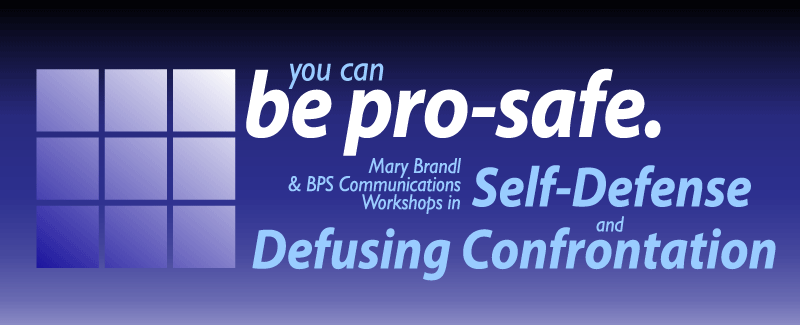

|
|||||
Effective
Self-Defense in a Short Workshop or Course by Mary Brandl (These excerpts appeared in the lead article of CONNECTIONS, the Wisconsin Coalition Against Sexual Assault (WCASA) Quarterly Newsletter, Volume VI, Issue III) |
Many people wonder if it is possible to learn effective self-defense in a short workshop or course. My answer is a resounding "YES!" based on the feedback I have received over the last fifteen years -- from people who've avoided assault or successfully defended themselves after as little as 45 minutes of instruction! This may surprise many people because movies, television shows, and even the news present a distorted picture of violence and victims. The media version of assaults shows powerful assailants leaping out of hiding to attack unsuspecting victims. The victims either have superior weapons and skills and subdue the attackers, or they are killed or captured (later to be rescued by someone who has the weapons and skills). If that were a realistic view of self-defense, a short workshop would hardly seem useful. there are, however, many things people can do to minimize the possibility of an assault. These things, based on a more realistic understanding of confrontation and violence, can be done with a minimum of training. Attackers commonly check out potential victims and follow routines that have worked in the past. In many potential assaults, if this routine is interrupted, the attacker will wait for something easier. For example, in order to feel they have psychological control of a situation, many attackers need to get physically close to potential victims. If an attacker cannot get close, he may decide not to continue. Many attackers will only attack from behind, turning to face them may discourage them. Strong body language, looking directed and aware of the surroundings, and verbal assertiveness are also options that could keep a situation from ever becoming a physical attack. Likewise, trusting one's feelings, being willing to attract attention, being able to override social conditioning, are powerful self-defense tools. In my workshops, I stress that we don't need to have every possible option, but we do need to be aware of the options we have. Nowhere have I learned more about pinpointing options than in the workshops and courses I've taught for people with special needs. I've come to view each individual as having a unique set of options. Learning to be concrete and specific in determining options has enhanced my presentations to 'mainstream' populations. For example, working with people who have developmental disabilities, I've learned to supplement my more abstract explanations of distance by referring simply to 'handshake distance.' If something about a person feel 'strange' or funny', don't let them inside your critical 'handshake distance.' When working with people who are deaf, rather than dwelling on their inability to hear someone approach, I help them be aware of their strengths. Deaf people are generally sharper than most hearing people at noticing nonverbal cues because they've had to be. They often have highly developed peripheral vision, are more sensitive to things like air flow from a door opening in, and are very adept at reading body language. I tell them, as I tell my hearing students, to trust their feelings and be willing to act on them since more communication is nonverbal. People who are blind or use wheelchairs have given me some wonderful stories about assertiveness. Well-meaning people often will try to help them without first asking if they want help (even to the point of trying to take them across a street they hadn't intended to cross!). Because of the unique situations they've had to face, many of them have become very strong in asserting their needs. They are used to saying thing like "thanks, but I prefer to do this by myself." That kind of practice makes them much less likely to follow their social conditioning in a situation when their gut is telling them something feels 'off.' Even if a situation requires physical resistance, it's important to concentrate on what is possible rather than on what is not, especially for someone who feels limited in their physical abilities. For example, once an attacker has grabbed and is in close, a blind person is very capable of boxing the attacker's ears, a potentially disabling technique. If an attacker leans over someone in a wheelchair to grab or strike, he is in an awkward position. Many wheelchair users have learned to take advantage of this position by striking the attacker's eye or throat or by pulling the attacker off balance. We need to understand that no one has every self-defense option. Many potentially serious situations have been resolved by some simple action. Good self-defense training should include psychological awareness and skills. Good self-defense training should keep physical options practical. With these elements present, even a short self-defense workshop or course could easily triple or quadruple a person's options. Many attackers have a limited repertoire; their advantage lies in that they have planned ahead. We can also plan ahead. Even a short course can give us a tremendous advantage by maximizing our self-defense options. (Have thoughts or opinions on this article? Feel free to send them to mary@beprosafe.com) |